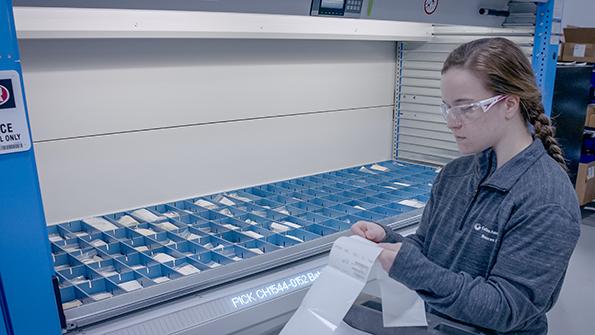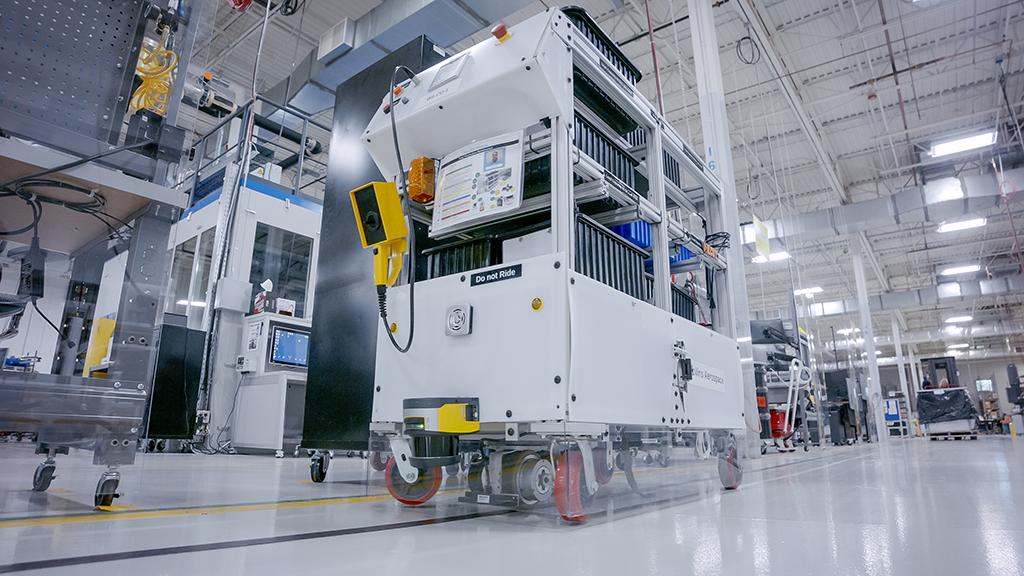
Although aftermarket demand has rapidly returned, MROs are facing a range of obstacles in ramping up to their full potential, including reduced workforces, supply chain shortages and capacity constraints. With no end in sight for many of these challenges, MRO providers are finding it more important than ever to seek efficiencies where possible—and some are leveraging technologies to increase productivity within their workforces.
One aftermarket company that began using technology for greater workforce efficiencies before the COVID-19 pandemic is Collins Aerospace. It has tapped various technologies across its MRO and manufacturing business units to make work faster, easier and more effective.
“We’re using automation and technology to free up our people to do higher-level, higher-order work,” explains Sam Mehta, president of advanced structures at Collins. “People want to progress. [They] also don’t necessarily want to be the person that sits there and counts the nuts and bolts that go into the tray. We’re using automation as a key lever to get our people to move and improve and continue to develop and advance their skills.”
One digital element Collins had in place pre-pandemic is automated optical inspections, which it uses to reduce error rates and time required to perform quality inspections. Driven by artificial intelligence (AI), these inspections are used across all of its business units. One of the first areas it was used was in Collins’ electronics assembly lines, where it previously had a high degree of failures.

“One of the things we’ve been able to do effectively as a company is take out some of the subjectivity around the evaluation of parts,” Mehta explains. “As we go through the quality process and we repair that part, and it goes back out to the field, having visual measurement and visual identification of the condition of that part” allows Collins to confirm that it meets all critical characteristics.
At its Monroe, North Carolina, MRO facilities, Collins has implemented several technologies to improve efficiency. The company’s Wilco 1 robot roams the shop floor, inspired by the Autonomous Intelligent Vehicle used at its Singapore innovation hub. The robots move items to different areas of the building, reducing walking distances and lead times for staff.
The facility also uses an automated vertical carousel system from Kardex Remstar to make the process of picking stored inventory safer and more efficient. In addition to freeing up shop floor space by storing inventory vertically, the carousel system rotates to bring picked items down to ground level, eliminating the need for ladders. Collins says the automated system has improved the speed, accuracy and efficiency of the picking process.
Collins has also implemented digital technology to monitor and improve efficiencies on the shop floor. It internally developed MROLife, a web-based application that gives a near-real-time overview of work in process. The application is used at workstations and central communication areas on shop floors, which Collins says increases transparency and communication throughout a facility. Collins says MROLife lets it prioritize work and resources, which enables optimized sequencing and reduced turnaround time for units in its facilities.
According to Mary DeStaffan, general manager at Collins’ Monroe facility, the technology includes live data cues to show operators which jobs are next in line. “If we get an urgent call from American [Airlines] or Delta [Air Lines] that says, ‘I know my part wasn’t due for another week, but I really need it this week,’ we can move it in the system,” DeStaffan says. “Then the operator knows exactly what they have to work out next.” She adds that the technology helps workers evaluate whether they are on track.
Collins says it uses data generated from automated reports to “understand deviations and track implemented improvements in our processes.” This enables faster reactions, which it says results in reduced turnaround times.
According to Kevin Myers, vice president of operations and quality at Collins, these technologies all work toward creating a digital product life cycle. “That [digital product life cycle] is connecting from design and development all the way through to MRO and making sure that there’s a seamless thread of data that flows through our system,” Myers says. He adds that “depending on where you’re at in the process—whether you’re a design engineer, shop floor employee or supplier—the information that you need flows to you as seamlessly and easily as possible.”
Another MRO implementing a variety of technologies to improve efficiencies is HAECO Americas. It is piloting 8tree’s dent-mapping technology at its Lake City, Florida, facility and it is working with Alaska Airlines on a pilot project using smart glass technology.
One new technology it is developing in Lake City is an AI-based camera system that maps and monitors elements such as vehicles, ground support equipment and workforce. According to Stephen Coley, general manager at HAECO Americas, the technology learns from the movements of these elements and creates a “digital spaghetti map.” The technology is designed to detect, track and categorize all movement around a facility, and it can be programmed to recognize features such as serial numbers on a particular piece of equipment.

When it comes to tracking workforce, Coley says the technology’s mapping and monitoring elements are used for scenarios such as figuring out why a person would need to go back and forth between different hangars multiple times a day. “That helps us properly stage the equipment tooling at the point of use versus the wasted hours of labor and, most importantly, the effort that our technicians and frontline team members are having to expel to do their job,” he says.
This technology can also pair with radio frequency identification (RFID) systems, which HAECO uses to tag and track tools. Coley says similar insights can be gleaned from RFID, such as whether to stage a tool in a different location or purchase another tool if it is regularly moving from hangar to hangar.
“What it allows you to do is see the waste, analyze it with the group, bring in the frontline team members and come up with a consensus on better solutions and ideas to make their lives easier and more effective,” Coley says.
While the business case for these types of efficiencies is evident from a management perspective, the average worker may be uneasy about having their movements and productivity tracked. When asked about achieving employee buy-in, Coley says HAECO explained to its staff that the technology is intended to help them rather than to keep tabs on their activities.
“We explained that the intent is to help,” he says. “The intent is to keep you from walking 3 mi. a day at work, because all of our facilities are huge. It was actually the frontline staff, who you would think might be a little bit timid, that took that and ran with it, and helped us implement it to make it better.”
Coley points out that involving employees in the implementation of new technologies is a key part of their acceptance. “If you involve somebody in the change, seek their feedback and gain that consensus, whether they agree with it fully or not, they will help march it forward themselves,” he says.
He also adds that HAECO is focused on creating a culture where ideas can be shared upstream as well as downstream. “We work very hard on creating a safe and open environment where everybody feels comfortable to share their ideas, ask questions and raise the flags, because that’s how we continue to get better, and that’s how we sustain our organizations,” Coley says.
Similarly, Mehta at Collins estimates that 80% or more of its creative ideas come from people working on the front lines: “I think most of the innovation that we have on the automation and visual inspection fronts comes from the people on the floor who say, ‘This process seems like it’s taken more time than it should.’” He adds that these types of activities also tend to be menial or monotonous tasks that “nobody wants to do,” so automation cost and labor reductions benefit everyone.
DeStaffan points out that Collins’ culture in Monroe encourages employee ideas and innovations. For instance, she says employees design their own work cells, so they can choose how they want tools arranged or what types of equipment they would prefer to use. One example is a customized cart used for MRO work on trimmable horizontal stabilizer actuators (THSA). DeStaffan says employees designed the cart so it could be raised and lowered to their working height and the THSA could be rotated 360 deg. for easier access to tight corners.





